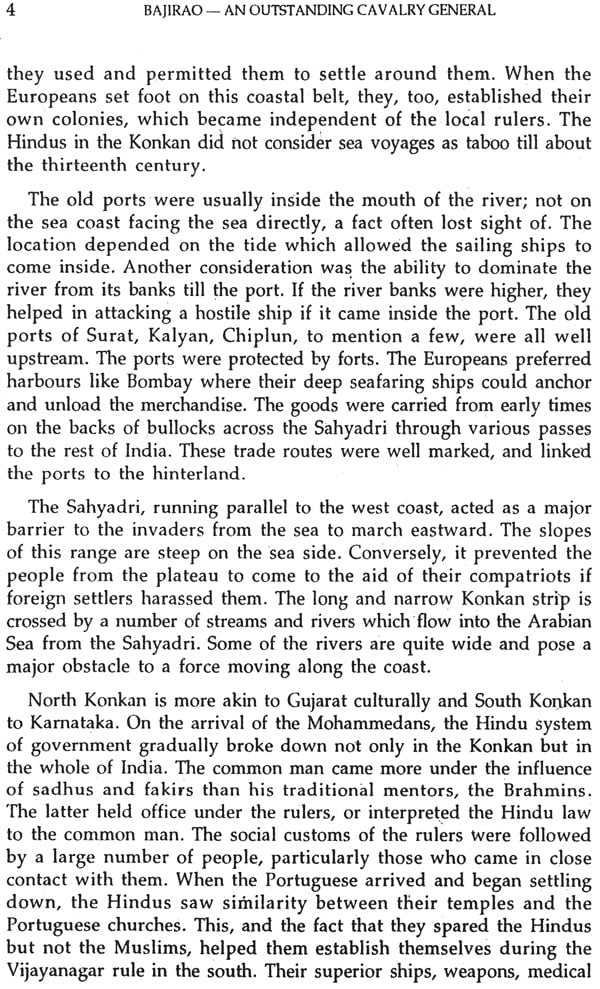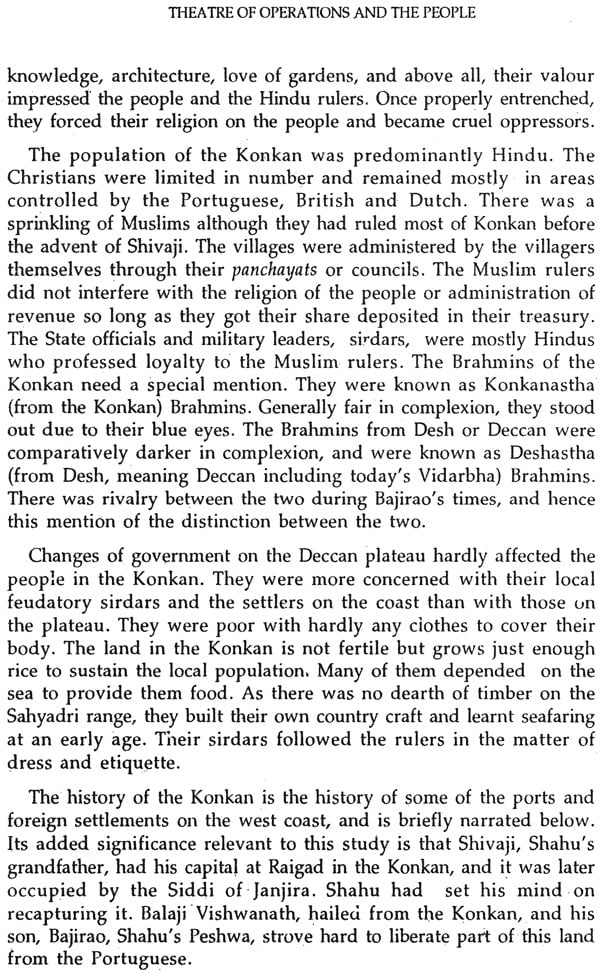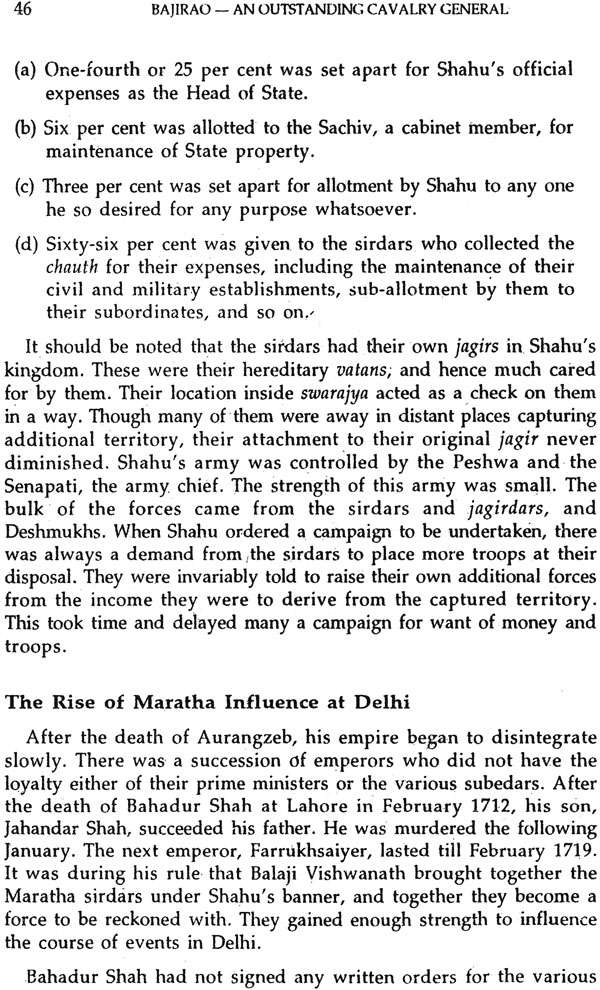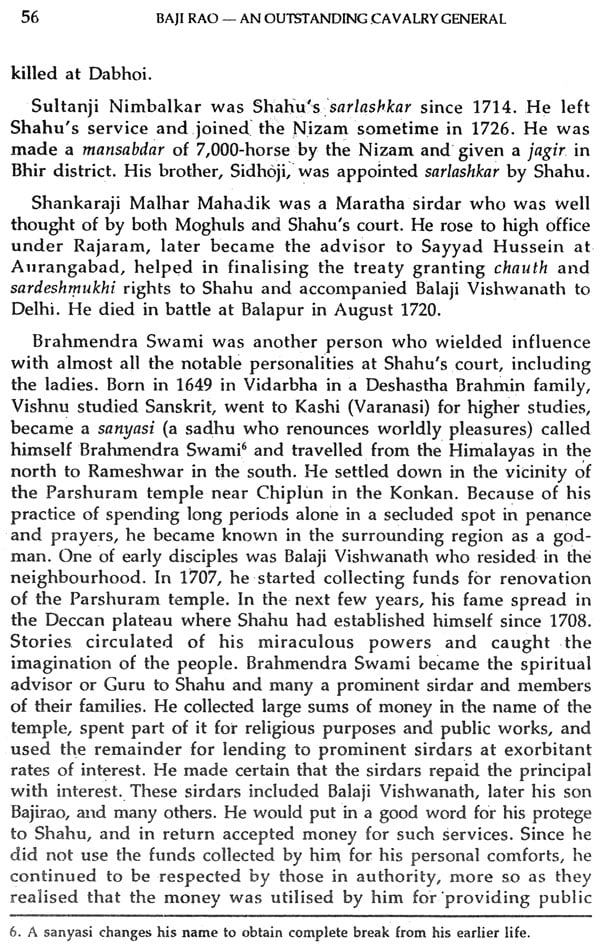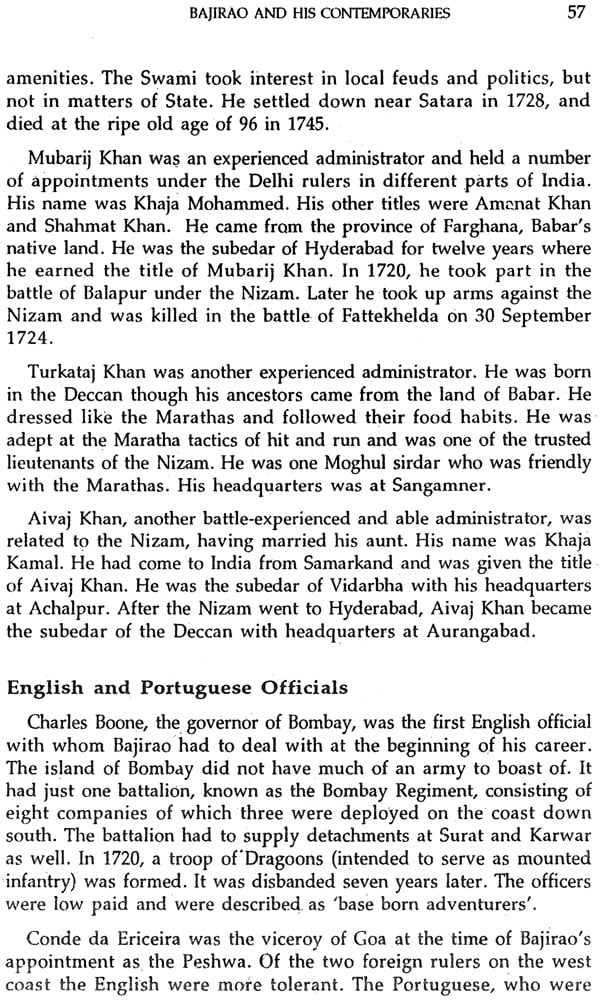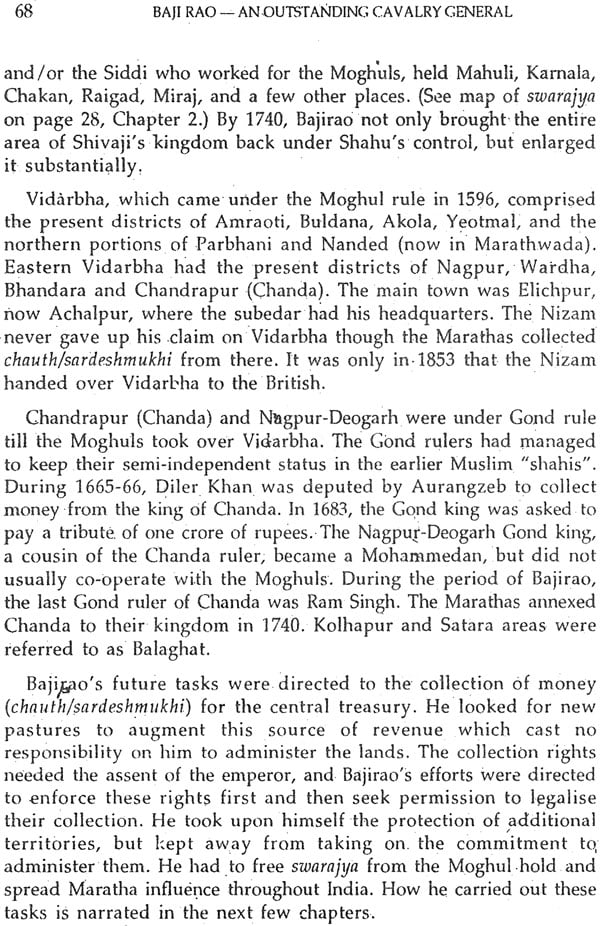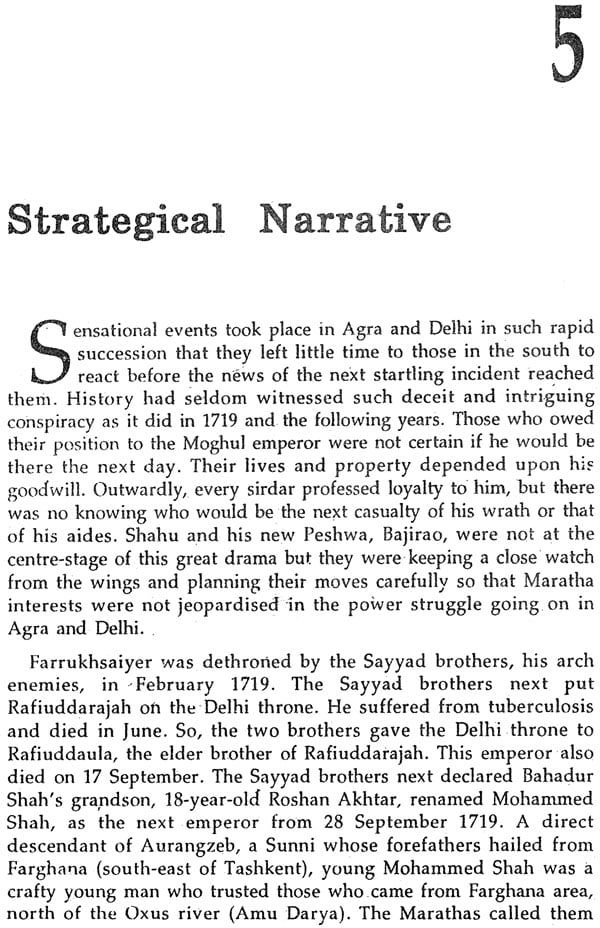
Bajiraoi - An Outstanding Cavalry General
Book Specification
| Item Code: | NAO897 |
| Author: | Col. R.d. Palsokar, M.C. |
| Publisher: | Merven Technologies, Pune |
| Language: | English |
| Edition: | 2020 |
| ISBN: | 9788193989586 |
| Pages: | 352 (16 B/W Maps) |
| Cover: | Hardcover |
| Other Details | 8.5 inch X 5.5 inch |
| Weight | 520 gm |
Book Description
Evers since he donned the robes of Peshwa in 1720 at the young age of twenty, Bajirao –Peshwa set about creating a forcce from amongest the simple, cheerful and vigrous Marathas around him. His generals came from all classes. One of them was a shepherd ; another low – caste Martha. Cast was no bar to promotion; he looked for qualities of leadership. After the death of Shivaji, the Maratha army had practically ceased to exist. He brought life into it by leading his troops personally in battle. Bajirao brough about a major change in the psyche of his mounted troops. He made full use of their mobility to charge the enemy infantry and cavalry alike and also to take on the enemy guns; and to lay sieges. This was a major departure from contemporary tactics, He was constantly on the move with his army. He never spent long periods of inaction at Pune.
His first test as a field commander came at Palkhed when he faced the strong army of the 55 –years –old Nizam, a veteran of many wars who had not known defeat in battle. He first made the Nizam chase him all over north, Mahabhartha, and finally, with his eye for ground successfully seprated the till then invincibale Nizam from his man force, cut of his rations and water supply and thus made him sign submissing treaty, thereby neutrilizing his influence for some time to come. He Humbled the Nizam a second time at Bhopal using similar tactics, With his ability to ride long distances with his troops, he reached Delhi despite the rout being barred by the armies of two of the most powerful Moghul sirdars. He created such fear in the mind of the emperor that the letter made preparations to leave Delhi.
His genrous behaviour towards his enemies acheived much for spreading and consolidating Maratha influence up to the Yamuna in north. The high –caste Brahmin that he was, fought as well as the Kshatriya, if not better.
In the wards of grant Duff, "when in the field with his troops he kept up no state and shared the privation, of the meanst horseman... Unlike most Brahmins of his times, he had both the hand to execute." Unfortunately, he passed away at the young age of 40. It is a pity that India has not produced a cavalry general of his caliber since then.
Colonel R.D. Palsokar, MS MCD, a B.Sc. of Nagpur University, had a brilliant academic career, he was commissioned in the 4th Grendiares and was later transferred to the Brigade of the Guards with the 1st Grenadiars. He saw frontline service in Burma, Kashmir, the Naga Hills and NEFA. He won two gallentry awards 197 the Milliatry Cross and the Cheif of the Army Staff's Commendation. He passed the Defence Services Staff College Courses in 1951, and held a number of important command, Staff and instructional appointments till his transfer to the Reserve in 1969. Besides the present book, he has written twenty –six others, including eleven militiary campaigns, eight regimental histories, five biographies, one in Hindi and one in Marathi. He has contributed articles to various militiary journals and periodcals, both in India and the U.S.A. Some of his articles have been translated in almost all the major Indian languages.
I am greatly pleased to write this Foreword for Ram Palsokar's book on the First Bajirao. We are old colleagues; our associations started in the middle sixties when I was the Commandant of the Indian Millitary Academy and he the Senior Trainning Staff Officer.
After retirement R.D.P started a new career – authorship of millitary historical books, some of which I have read. It was for the encouragement and promotion of millitary studies, particularly history, I wrote to my old friend and suggested that he undertake reasearch into certain aspects of Maratha wars leading up to the Maratha Confederacy and the Anglo –Maratha Campaigns, Much has been writtten on the subject giving the British viewpoint and slant: not enough from the Indian side. This project was especially appropriate since new archives (such as the Peshwa Office records) are now available for researches and students.
In 1993, R.D.P finally agreed to take up the quest : and the present book is the result. For me this is an especially felicious occasion because though four Fellowship have so far been awarded by the Board of Trustless of my Millitary Studies Trust, this will be the first book to appear under our sponsership. It brings out new facts of Bajirao's generalship and the foundation he laid for establishing a Maratha empire, which slowly lived up to the great though shortlived Maratha Confederacy of the 18th and early 19th centuries.
During the course of my study of the biographs of Indian generals, I analysed the campaigns of Babar, Shivaji and Tipu Sultan and published my result in book form during the 1970s. I then switched on to the study of Europeon campaigns, biographs of famous Europeon generals, and next worked on some regiment histories.
In early 1984, I was asked by the All –India Radio, Pune, to give a talk on the generalship of Bajirao Peshwa. I had to do some quick reading, and discovered to my astonisment that here was an outstanding cavalry general the like of whom India had not seen for generaltions, who merits a place in history with the likes of Napoleon Rommel and von Manstein. Nepolian was 28 years old when he took same age when he brought the powerful Nizam, who had not known defeat in battle, to sign a treaty of freindship with him after the battle of Palkhad. Just as Napoleon excelled in manoeuvring his troops in such a way that he brought a superior force at the point of attack, Bajirao did the same, but in a different manner at Palkhed. He separated the Nizam from his main body, and them cut him off from his supplies.
Bajirao fully exploited the mobility of the horse and moved at great spped over long distances. His opponents could never fathom where he was heading for. He was bold and valiant, and was not afraid to attack Moghul troops even when they outnumbered him, Added to it was a keen eye for the ground; one hasty survey and he would decide if it was suitable to give battle.
I made these general observations in my talk but did not study Bajirao's tactics deeply. I again got engrossed in other millitary studies till Genral Palit prodded me to accept the Fellowhip at the Indian Defence Studies and Analysis under the provisions of his Millitary History Trust and to undertake the study of Bajirao's generalship. The result of his encouragement and guidence, including the valueable corrections he so painstakingly make in the MSS, is what I present to the reader.
I would not like to repeat my observations about Bajirao's generalship again here which I have summarised in the last chapter the Epilogue, I would like to quote the last sentence in it once again here: "It is a pity that India did not produce an outstanding cavelry general of Bajirao's calibrate after 1740 –not to the present day."
Contents
| Content | Page NO. |
| Foreword | V |
| Preface | VI |
| Maps | XIV |
| Chapter 1: Theatre of Operations and The People | 1 |
| The Konkan | 3 |
| Bombay Chaul and Janjira | 6 |
| Chaul and Janjira | 6 |
| Goa and Vengurla | 7 |
| The Deccan | 8 |
| Historical Background | 9 |
| Bahamani Rule and the Five "Shahis" | 9 |
| The Advent of the Moghulls; their Different Systems | 12 |
| The Rise of the Maratha Power | 13 |
| The Armies in the Deccan | 17 |
| Chapter 2: Evolution of the Maratha Army and Navy | 19 |
| Origin of the Maratha Army | 19 |
| Early Tactics -Hit and Run; Raising of a Navy | 21 |
| The Shiledari and Bargir System; the Forts | 23 |
| Change of Tactics -Destruction of Enemy Force | 24 |
| Major Change in Tactics | 26 |
| Sambhaji -The New Ruler | 28 |
| Aurangzeb Comes to Deccan | 29 |
| Rajaram -The Beginning of Guerrvilla Warfare | 30 |
| Origin of the Maratha Confederacy; Vatans Restored | 32 |
| Tarabhai's Rule; Shahu's Release | 34 |
| Chapter 3: Re-establishment of Maratha Power | 37 |
| Tarabhai Loses at Khed, 1707 | 38 |
| Chauth and Sardeshmuhi Rights | 39 |
| Balaji Vishwanath Bhat | 42 |
| Nizam ul Mulk | 43 |
| The Theory and Practices of Confederacy | 44 |
| The Rise of Maratha Influence at Delhi | 46 |
| Balaji Vishwanath Obtains Collection Rights | 47 |
| Relations with the English and the Portuguese | 49 |
| Balaji Vishwanath's Contribution to Swarajya | 50 |
| Chapter 4: Bajirao and His Contemporaries | 51 |
| Relatives and Contemporaires | 53 |
| English and Portuguese Officials | 57 |
| The Legacy -Political and Military | 59 |
| The Quality of the Cavalry and Infanitry | 60 |
| Bajirao's Strong Points | 63 |
| Bajirao's Weak Points | 64 |
| Administrative Division of Maharastra | 66 |
| Chapter 5: Strategical Narrative | 69 |
| Rajput Rullers; their Background | 70 |
| Battles of Khandwa and Balapur -June -july 1720 | 72 |
| Bajirao Joins Alam Ali | 74 |
| The Rise of Nizam ul Mulk | 75 |
| Bajirao Meets the Nizam | 76 |
| Nizam Appointed Vazir | 77 |
| Deteriorating Relations | 77 |
| Naval Strenght; Bajirao Leads Troops | 78 |
| Bajirao Meets the Nizam Again | 81 |
| Nizam's Fight for Survival -Bajirao's Role | 83 |
| Battle of Fattekhelda, 30 September 1724 | 85 |
| Shahmat Panah Bajirao | 86 |
| Nizam Becomes Founder of Asaf Jahi Dynasty | 87 |
| Chapter 6: The Karnatka Campaigns | 89 |
| Maratha in Gujrat and Movie | 89 |
| The Chitraduga Campaign: Nov. 1725 -May 1726 | 92 |
| Maratha in Gujrat and Malwa -Continued | 95 |
| The Srirangapatna Campaign: | 97 |
| Chapter 7: Palkhed -A Victory by Stratagem | 99 |
| Preparations for Battle | 100 |
| Preliminary Skirmishes: Sinnar Area | 101 |
| Nizam's Initial Moves | 103 |
| Bajirao Heads for Aurangabad and Bashim | 103 |
| Nizam's Deliberate and Slow Moves | 105 |
| Ground and Rival Dispositions | 107 |
| The Stratagem Works | 110 |
| Nizam Sues for Peace | 112 |
| Bajirao's Tactics at Palkhed | 113 |
| Contemporary Europeon Armies -A Comparision | 114 |
| Bajirao's Cavalry -Truly Mobile | 115 |
| Bajirao's Speed of Movement - A Mystifying Factor | 117 |
| Role of Forts and Infantry | 117 |
| Relation to Strategy | 119 |
| Money,Money and Again Money | 120 |
| Chapter 8: Into Malwa and Bundelkhand | 121 |
| The Bhosles of Nagpur | 122 |
| Raja Giridhar Bahadur and Mohd, Khan Bangash | 123 |
| A Note on the Geography of Malwa | 124 |
| Chaotic Conditions in Malwa; Marathas Invited | 125 |
| Giridhar Bahadur and Daya Bahadur Killed | 126 |
| The Ujjain Siegs; December 1728 | 128 |
| Comments on the Malwa Campaign | 130 |
| Bajirao Moves to Bundelkhand | 130 |
| Bundelkhand -Previous History | 131 |
| Mohammed Khan Bangesh Humbled | 132 |
| Bajirao - Third Son of Chhatrasal | 133 |
| The Division of Malwa and its Income | 135 |
| Comments on the Bundelkhand Campaign | 136 |
| Chapter 9: Battle of Dabhoi | 139 |
| The Background | 140 |
| Shahu's Campaign against Sambhaji | 142 |
| The Dadhade -Nizam Axis | 142 |
| Dadhade's Movements | 143 |
| Nizam Meets Bangesh -March 1731 | 143 |
| Bajirao's Rapid Movements | 144 |
| Attempts towards Amicable Settlement | 146 |
| Battle of Dabhoi -1 April 1731 | 147 |
| Bajirao's Tactics | 150 |
| Bajirao in Virtual Control in Malwa | 153 |
| The Aftermath Within | 154 |
| Treaty with the Portuguese | 155 |
| Chapter 10: A Minor Campaign -Janjira | 157 |
| The Siddies on the West Coast | 158 |
| The Angres | 159 |
| Martha Aspirations | 161 |
| Bajirao Meets Nizam - A Secret Agreement? | 163 |
| Death of Siddi Yakut | 164 |
| The Janjira Campaign | 165 |
| Overall Poor Performance | 171 |
| Chapter 11: In The Full Tide of Success | 173 |
| Affairs in the North | 173 |
| Bajirao's Mother to Varanasi | 178 |
| The Janjira Campaign -Continued | 178 |
| The Portguese Reactions | 179 |
| The End Of Siddi Sat | 181 |
| Affairs in the North -Continued | 182 |
| Bajirao Leaves for Udaipur -Jaipur | 183 |
| On to Delhi | 184 |
| The Advance on Delhi | 185 |
| Bajirao's Appreciation and Plan | 187 |
| Bajirao Elaborates His Tactics | 191 |
| The Nizam Moves North | 192 |
| Chapter 12: The Battle of Bhopal | 195 |
| Nizam Honoured; His Demands Met | 195 |
| Nizam Moves South via Bundelkhand | 197 |
| Bajirao Leaves Pune to Confront the Nizam | 197 |
| The Battleground at Bhopal | 198 |
| The Battle | 200 |
| Nizam Signs Peace Terms | 205 |
| Bajirao's Comments on the Peace Terms | 206 |
| Comments on Bajirao's Tactics | 206 |
| Chapter 13: The Battle of Vassi | 208 |
| Chimaji's Battles against the Portuguese | 208 |
| Bajirao Slighted by the Portuguesed | 209 |
| Area of Operations | 209 |
| Fall of Thane and Occupation of Sashti | 210 |
| Set -back at Vasai and in Sashti | 212 |
| Bajirao Reinforces Thane, Sashti, Daman | 214 |
| The Maratha Offensive Begins | 214 |
| Mahim Recaptured | 215 |
| Tarapur Captured | 216 |
| The Battle for Vasai | 217 |
| Maratha Magnanimity in Victory | 219 |
| Comments on the Vasai Campaign | 219 |
| Shahu's Expedition | 220 |
| Nadir Shah in Delhi | 220 |
| Bajirao's Last Campaign | 221 |
| Chapter 14: Epilogue | 225 |
| The Strategic Scene | 226 |
| An Orthodox Brahmin Turned Good Kshatriya | 227 |
| A Reconciler, not a Destroyer | 228 |
| In Malwa, Gujrat and Bundelkhand | 229 |
| Wooing the People | 230 |
| As an Administrator | 231 |
| As a National Leader | 232 |
| As a General | 233 |
| The Maratha Cavalry at its Zenith | 233 |
| Cavalry and the Forts | 234 |
| Generals from All Classes | 235 |
| Offensive Action and Surprise | 235 |
| Bajirao's Achievements | 236 |
| Biblography | 239 |
| Index | 241 |
Sample Pages
